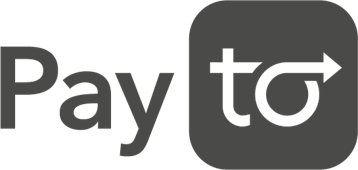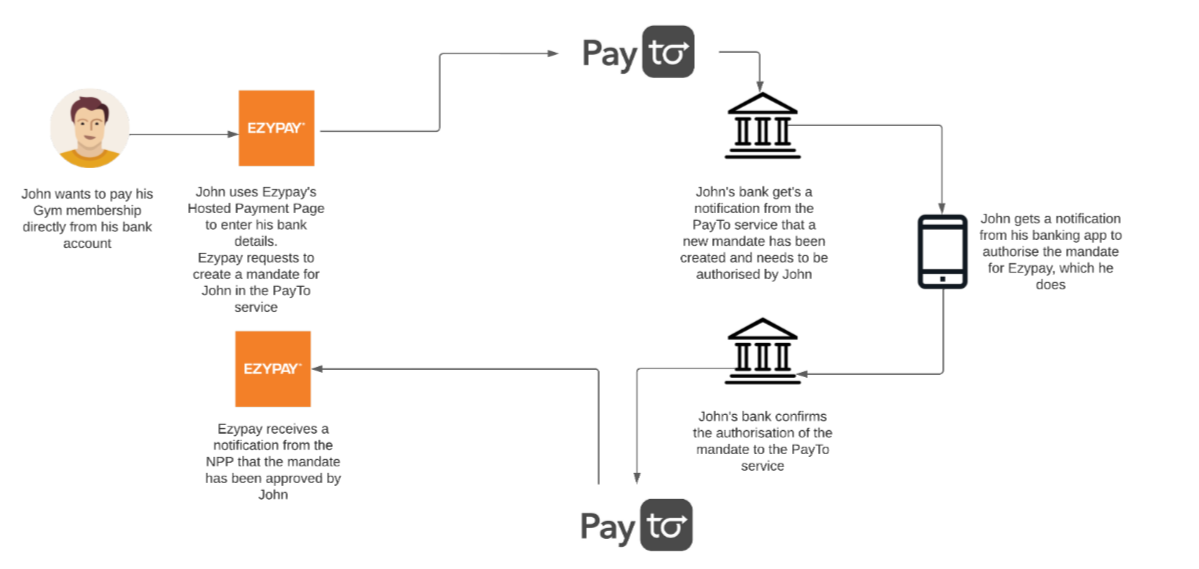About PayTo

PayTo is a component of the New Payment Platform (NPP) in Australia. PayTo allows Australian merchants to debit their customers' bank accounts in real-time rather than waiting up to three working days with traditional direct debits. For more information on PayTo, please refer to PayTo website.
To bill a customer using PayTo, the customer must first authorise an agreement (PayTo mandate), which can be managed within the customer's banking app.
Below is the process flow on how PayTo works:

PayTo Process Flow Diagram
AttentionPayTo is available in Australia only.
Benefits of PayTo
PayTo is the latest innovation in payments in Australia and offers several benefits to businesses processing recurring payments:
-
Faster processing time
Traditional direct debits take up to three working days before a response is received, meaning it could be up to three days before a merchant is notified that a customer's payment failed. With PayTo, payment responses are immediate. -
Improved cashflow certainty
PayTo is designed to maximise collection rates and improve cash flow by processing payments in real-time. Payment statuses are known instantly, allowing for prompt follow-up with customers on failed payments, improving the chances of collection and reducing the impact on cash flow. -
Enhanced security
Customers provide digital approval of their payments through the agreement, significantly reducing the chance of fraudulent activity. This provides nearly irrefutable evidence of customer approval to debit, resulting in fewer chargebacks. -
Allowing customers to self-service
Customers can move their PayTo agreement from one bank account to another with ease. Customers can also transfer all their PayTo agreements to the new account without needing to contact the merchant. This ensures that the correct account is billed each time.
LimitationsNot all banking institutions support PayTo. If a customer uses a bank that does not support PayTo during sign-up, they will receive a notification and need to select a different bank or payment method.
PayTo mandate agreement statuses
PayTo mandate agreements have their unique status and can change based on customers' actions. Therefore, it is important to understand the meaning of the statuses and the actions required by integrators.
PayTo agreement status | Actions Triggering this status | Related webhooks | Integrator's action |
|---|---|---|---|
CRTD - Created | Customer register PayTo payment method using Hosted Payment Page and it is linked to a customer. | payment_method_linked | Record the payment method token returned by Hosted Payment Page and linked it to customer. Will need to wait for customer to approve the agreement before it can be used in invoices. |
ACTV - Activated | Agreement has been approved by the account holder | payment_method_valid | All ready and you can initiate billing using this PayTo payment method. |
CNCD - Cancelled | -Account holder declines ‘Created’ agreement | payment_method_invalid | Stop any billing with the payment method token. The agreement is cancelled and billing will failed if process with this payment method. Reach out to customer and understand why the mandate is cancelled. |
SUSD - Suspended | -Paused by Initiator (Ezypay) | payment_method_invalid | Stop any billing with the payment method token. The agreement is suspended and billing will failed if process with this payment method. Reach out to customer and understand why the agreement is suspended. |
PayID
PayID is another component under the New Payment Platform (NPP) in Australia, similar to PayTo. Its core function is to allow banks to identify an actual bank account number using registered contact information (e.g., mobile number or email address). This improves customer experience as they do not need to remember lengthy bank account numbers to perform transactions. PayTo integration supports PayID, enabling customers to register a payment method with Ezypay using contact information. This keeps the underlying bank account number hidden, thereby enhancing security.
Updated about 2 months ago